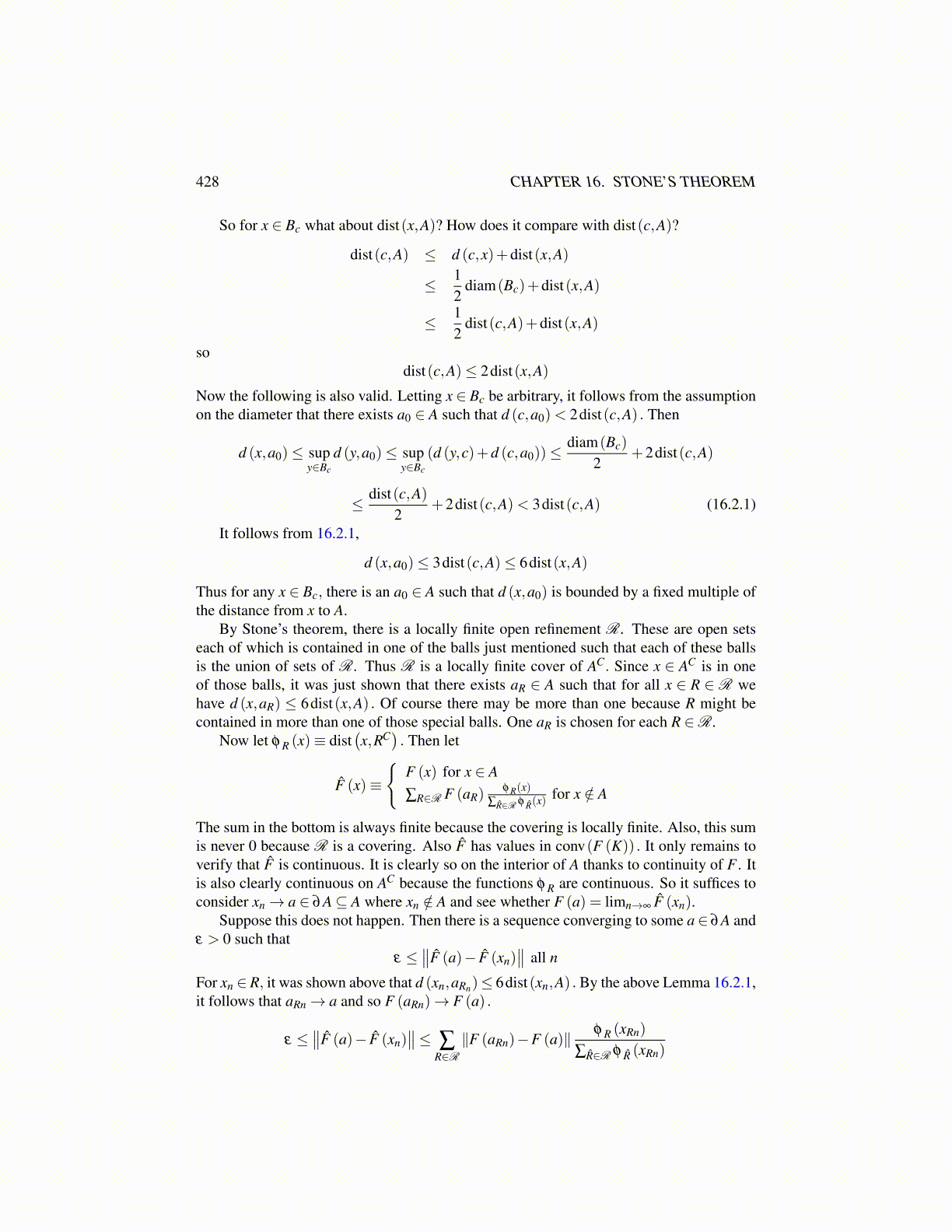
428 CHAPTER 16. STONE’S THEOREM
So for x ∈ Bc what about dist(x,A)? How does it compare with dist(c,A)?
dist(c,A) ≤ d (c,x)+dist(x,A)
≤ 12
diam(Bc)+dist(x,A)
≤ 12
dist(c,A)+dist(x,A)
sodist(c,A)≤ 2dist(x,A)
Now the following is also valid. Letting x ∈ Bc be arbitrary, it follows from the assumptionon the diameter that there exists a0 ∈ A such that d (c,a0)< 2dist(c,A) . Then
d (x,a0)≤ supy∈Bc
d (y,a0)≤ supy∈Bc
(d (y,c)+d (c,a0))≤diam(Bc)
2+2dist(c,A)
≤ dist(c,A)2
+2dist(c,A)< 3dist(c,A) (16.2.1)
It follows from 16.2.1,
d (x,a0)≤ 3dist(c,A)≤ 6dist(x,A)
Thus for any x ∈ Bc, there is an a0 ∈ A such that d (x,a0) is bounded by a fixed multiple ofthe distance from x to A.
By Stone’s theorem, there is a locally finite open refinement R. These are open setseach of which is contained in one of the balls just mentioned such that each of these ballsis the union of sets of R. Thus R is a locally finite cover of AC. Since x ∈ AC is in oneof those balls, it was just shown that there exists aR ∈ A such that for all x ∈ R ∈ R wehave d (x,aR) ≤ 6dist(x,A) . Of course there may be more than one because R might becontained in more than one of those special balls. One aR is chosen for each R ∈R.
Now let φ R (x)≡ dist(x,RC
). Then let
F̂ (x)≡
{F (x) for x ∈ A
∑R∈R F (aR)φR(x)
∑R̂∈R φ R̂(x)for x /∈ A
The sum in the bottom is always finite because the covering is locally finite. Also, this sumis never 0 because R is a covering. Also F̂ has values in conv(F (K)) . It only remains toverify that F̂ is continuous. It is clearly so on the interior of A thanks to continuity of F . Itis also clearly continuous on AC because the functions φ R are continuous. So it suffices toconsider xn→ a ∈ ∂A⊆ A where xn /∈ A and see whether F (a) = limn→∞ F̂ (xn).
Suppose this does not happen. Then there is a sequence converging to some a∈ ∂A andε > 0 such that
ε ≤∥∥F̂ (a)− F̂ (xn)
∥∥ all n
For xn ∈R, it was shown above that d (xn,aRn)≤ 6dist(xn,A) . By the above Lemma 16.2.1,it follows that aRn→ a and so F (aRn)→ F (a) .
ε ≤∥∥F̂ (a)− F̂ (xn)
∥∥≤ ∑R∈R∥F (aRn)−F (a)∥ φ R (xRn)
∑R̂∈R φ R̂ (xRn)